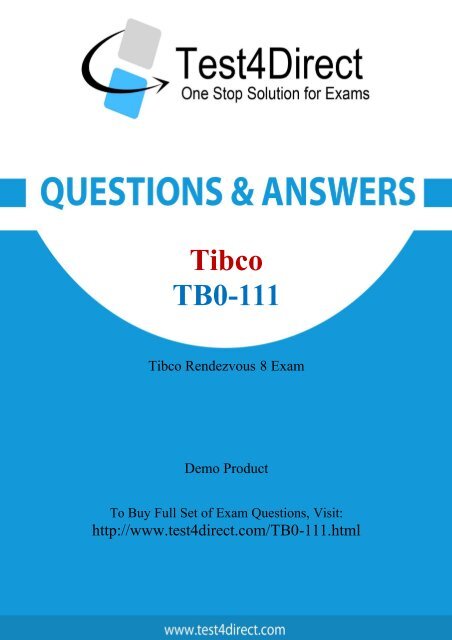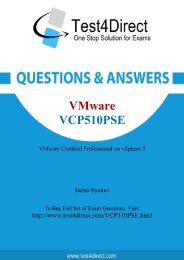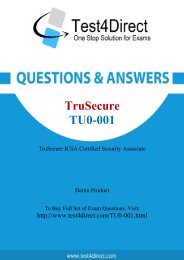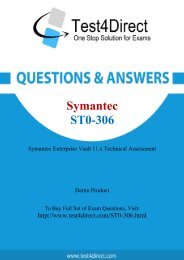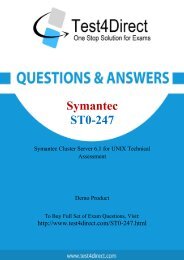TB0-111 Real BrainDumps
Test4Direct provides latest PDF questions of Tibco TB0-111 exam. You have an opportunity to pass the Tibco TB0-111 exam in one go. Test4Direct is most accurate source to prepare Tibco TB0-111 exam as your success will become site’s responsibility after purchasing TB0-111 exam product. There are also lots of discounts and promotion offers that you can avail. Let’s try a free demo http://www.test4direct.com/TB0-111.html
Test4Direct provides latest PDF questions of Tibco TB0-111 exam. You have an opportunity to pass the Tibco TB0-111 exam in one go. Test4Direct is most accurate source to prepare Tibco TB0-111 exam as your success will become site’s responsibility after purchasing TB0-111 exam product. There are also lots of discounts and promotion offers that you can avail. Let’s try a free demo http://www.test4direct.com/TB0-111.html
You also want an ePaper? Increase the reach of your titles
YUMPU automatically turns print PDFs into web optimized ePapers that Google loves.
Tibco<br />
<strong>TB0</strong>-<strong>111</strong><br />
Tibco Rendezvous 8 Exam<br />
Demo Product<br />
To Buy Full Set of Exam Questions, Visit:<br />
http://www.test4direct.com/<strong>TB0</strong>-<strong>111</strong>.html
Question: 1<br />
The following is the declaration of secure daemon in Rendezvous C API: tibrv_status<br />
tibrvSecureDaemon_SetUserCertWithKey( const char* userCertWithKey, const char* password);<br />
Which two statements are correct about this function? (Choose two.)<br />
A. The password parameter is used to decrypt the private key.<br />
B. The password parameter is used for the password for this user.<br />
C. The userCertWithKey parameter is used to register user certificate with a private key. The text of<br />
this certificate must be in PEM encoding.<br />
D. The userCertWithKey parameter is used to register user certificate with a private key. The text of<br />
this certificate may be in PEM or PK12 encoding.<br />
Question: 2<br />
Which statement is correct about Rendezvous fault-tolerant groups (RVFTs)?<br />
Question: 3<br />
Question: 4<br />
Answer: A,C<br />
A. RVFT is an election protocol that tells an application when it is active or inactive.<br />
B. RVFT can only be utilized for message producers, not for message consumers.<br />
C. For reliable consumers bound to an RVFT transport, the RVFT transport automatically disables<br />
subscriptions if the fault-tolerant group member becomes inactive.<br />
D. For certified consumers bound to an RVFT transport, the RVFT transport automatically confirms<br />
messages if the fault-tolerant group member becomes inactive.<br />
E. For certified consumers bound to an RVFT transport, the RVFT transport automatically cancels the<br />
certified agreement if the fault-tolerant group member becomes inactive.<br />
Answer: A<br />
Which advisory message does a Rendezvous fault-tolerant member present when other group<br />
members use parameters that do not match its corresponding parameters?<br />
A. _RV.ERROR.RVFT.PARAM_MISMATCH.group<br />
B. _RV.ERROR.RVFT.PARAM_COLLISION.group<br />
C. _RV.ERROR.RVFT.MEMBER_UNAVAILABLE.group<br />
D. _RV.ERROR.RVFT.MEMBER_PARAM_MISMATCH.group<br />
Answer: A<br />
Which three activities can be configured through the Rendezvous routing daemon (RVRD) HTTP<br />
interface to be routinely output to the RVRD log file? (Choose three.)
A. Subject Data: to log all messages that this routing daemon forwards to its neighbors or receives<br />
from its neighbors<br />
B. Connections: to log connection activity whenever this routing daemon establishes or closes a<br />
connection to a neighbor<br />
C. Client: to log RVRD local client connection activity whenever a client application establishes or<br />
closes a connection to the routing daemon<br />
D. Subject interest: to log all subscription requests (notification of listening) that this routing daemon<br />
sends to its neighbors or receives from its neighbors<br />
E. Remote: to log RVRD remote client connection activity whenever a remote client application<br />
establishes or closes a connection to the routing daemon<br />
Question: 5<br />
Question: 6<br />
Answer: A,B,D<br />
Which two situations can trigger the presentation of a SCHEDULER.OVERFLOW advisory? (Choose<br />
two.)<br />
A. Scheduler has set a task backlog limit.<br />
B. Scheduler has not set a task backlog limit.<br />
C. Scheduler is accepting new tasks, but discarding old ones on a FIFO basis.<br />
D. The Scheduler backlog limit has been reached and new tasks are being discarded.<br />
Question: 7<br />
Answer: A,D<br />
With TIBCO Rendezvous messaging, which networking protocol does the client application use to<br />
connect to the Rendezvous daemon (RVD)?<br />
A. SSL<br />
B. TCP<br />
C. UDP<br />
D. HTTP<br />
Which two statement are correct about certified delivery confirmation? (Choose two.)<br />
Answer: D<br />
A. Explicit confirmation of message delivery by the listening program is the default behavior.<br />
B. When confirmation reaches the certified sender, the transport presents a DELIVERY.CONFIRM<br />
advisory.<br />
C. Automatic confirmation of message delivery upon return from the callback function is the default<br />
behavior.<br />
D. When confirmation reaches the certified listener, the transport presents a DELIVERY.CONFIRM<br />
advisory.
E. When confirmation reaches the certified sender, the transport presents a DELIVERY.COMPLETE<br />
advisory.<br />
Question: 8<br />
Question: 9<br />
Answer: B,C<br />
When programming a TIBCO Rendezvous fault-tolerant application, it is a documented best practice<br />
to associate fault-tolerant member events with _____.<br />
A. a low-priority queue<br />
B. a high-priority queue<br />
C. a system event queue<br />
D. the default event queue<br />
Question: 10<br />
Answer: B<br />
You plan to test a network to ensure that it meets the following requirements: 100,000 point-topoint<br />
messages to be published by a single source in batch mode with ten messages per batch with<br />
an interval gap of 10 milliseconds. What is the correct rvperfm command to start a test run?<br />
A. rvperfm -service 7501 -daemon 7500 -inbox -messages 100000 -interval 10 -batch 10<br />
B. rvperfm -service 7500 -daemon 7500 -inbox -messages 100000 -interval 0.01 -batch 10<br />
C. rvperfm -service 7500 -daemon 7500 -subject PTP -messages 100000 -interval 10 -batch 10<br />
D. rvperfm -service 7501 -daemon 7500 -subject _INBOX -messages 100000 -interval 10 -batch 10<br />
E. rvperfm -service 7501 -daemon 7500 -subject _PTP -messages 100000 -interval 0.01 -batch 10<br />
Click the Exhibit button.<br />
Answer: B
Which menu option shown in the exhibit is used for setting the default service and network for<br />
Rendezvous secure daemons (RVSDs)?<br />
A. Users<br />
B. Services<br />
C. XML Configuration<br />
D. Daemon Parameters<br />
E. Networks and Services<br />
Question: 11<br />
Question: 12<br />
Question: 13<br />
Answer: D<br />
tibrvlisten is started with the following settings: -network ";224.2.2.2;224.6.6.6" "mytest" tibrvsend is<br />
started with the following settings: -network ";224.6.6.6;224.2.2.2" "mytest". "message #1" What is<br />
the expected result?<br />
A. The listener receives "message #1" only when run on a different host than the sender.<br />
B. The listener does not receive "message #1" when run on a different host than the sender.<br />
C. The listener will receive the message only if both the listener and sender run on the same host.<br />
D. The listener will receive the message only if both the listener and sender connect remotely to the<br />
same daemon.<br />
Answer: A<br />
Your back-end processing supports multi-threading and you plan to leverage this capability in the<br />
context of a Rendezvous distributed queue (RVCMQ) subscriber by running five concurrent threads.<br />
Which statement is correct?<br />
A. RVCMQ scales by multiple program instances (horizontally), not by multi-threading (vertically).<br />
B. Each distributed queue member receives as many messages as specified by the scheduler<br />
configuration (the scheduler tasks parameter must be set to 5 or greater).<br />
C. Each distributed queue member receives as many messages as specified by the worker tasks<br />
parameter (the worker tasks parameter of each queue member must be equal to or greater than 5).<br />
D. Each distributed queue member receives as many messages as it dispatches (nothing needs to be<br />
done from a RVCMQ standpoint as it is a matter of the multi-threaded message dispatching).<br />
Answer: C<br />
A publisher application uses a transport with UDP port number 8600 and multicast group 239.1.1.1.<br />
Which two sets of transport parameters enable a subscriber application to receive messages from<br />
the publisher? (Choose two.)<br />
A. Service 6800, Network ";239.1.1.0;239.1.1.1"<br />
B. Service 8600, Network ";239.1.1.0;239.1.1.1"
C. Service 8600, Network ";239.1.1.1,239.1.1.0"<br />
D. Service 8600, Network ";239.1.1.0,239.1.1.1;239.1.1.1"<br />
Answer: C,D<br />
Question: 14<br />
Which statement is correct about the _RV.INFO.RVCM.DELIVERY.CONFIRM.subject advisory?<br />
A. A listener sends this advisory to confirm receipt of a certified message.<br />
B. The sender presents this advisory after deleting the message from its ledger.<br />
C. A sender presents this advisory whenever a registered listener confirms receipt of a certified<br />
message.<br />
D. A sender presents this advisory when all registered listeners have either confirmed delivery of a<br />
certified message, or canceled interest in receiving it.<br />
Question: 15<br />
Which two statements are correct about fault-tolerant groups? (Choose two.)<br />
Answer: B<br />
A. Members of a fault-tolerant group are ranked by means of the specified member weight.<br />
B. Fault-tolerant groups implement a K of N active strategy (K member of a group is active while N-K<br />
members are passive).<br />
C. Members of a fault-tolerant group are ranked by means of the specified member weight, which<br />
must be a unique value within the fault-tolerant group.<br />
D. Members of a fault-tolerant group are ranked by means of the specified member weight.<br />
Members with equal weight are ranked by the time they joined the fault-tolerant group.<br />
E. The members of a fault-tolerant group are ranked by means of the specified member weight.<br />
Members with equal weight are ranked by non-deterministic means opaque to programs.<br />
Answer: B,E
THANKS FOR TRYING THE DEMO OF OUR PRODUCT<br />
Visit Our Site to Purchase the Full Set of Actual <strong>TB0</strong>-<strong>111</strong> Exam Questions With Answers.<br />
http://www.test4direct.com/<strong>TB0</strong>-<strong>111</strong>.html<br />
We Also Provide Practice Exam Software That Simulates <strong>Real</strong> Exam Environment And Has<br />
Many Self-Assessment Features. Download Free Product Demo From:<br />
http://www.test4direct.com/<strong>TB0</strong>-<strong>111</strong>.html<br />
Money Back Guarantee<br />
Check Out Our Customer Testimonials


